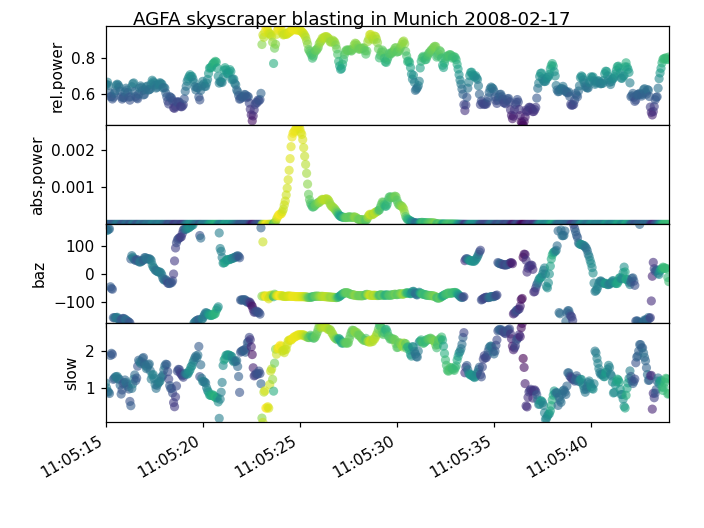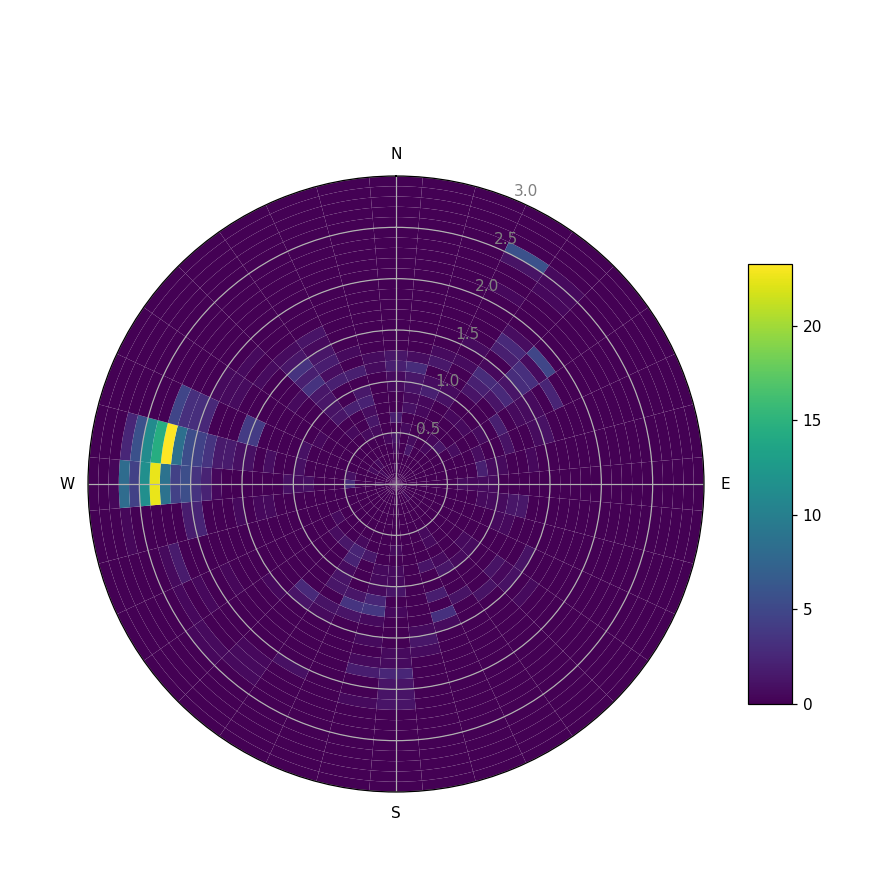Beamforming - FK Analysis
The following code shows how to do an FK Analysis with ObsPy. The data are from
the blasting of the AGFA skyscraper in Munich. We execute
array_processing() using the following
settings:
The slowness grid is set to corner values of -3.0 to 3.0 s/km with a step fraction of
sl_s = 0.03.The window length is 1.0 s, using a step fraction of 0.05 s.
The data is bandpass filtered, using corners at 1.0 and 8.0 Hz, prewhitening is disabled.
semb_thresandvel_thresare set to infinitesimally small numbers and must not be changed.The
timestampwill be written in'mlabday', which can be read directly by our plotting routine.stimeandetimehave to be given in the UTCDateTime format.
The output will be stored in out.
The second half shows how to plot the output. We use the output
out produced by array_processing(),
which are numpy ndarrays containing timestamp,
relative power, absolute power, backazimuth, slowness. The colorbar corresponds
to relative power.
import matplotlib.pyplot as plt
import matplotlib.dates as mdates
import obspy
from obspy.core.util import AttribDict
from obspy.imaging.cm import obspy_sequential
from obspy.signal.invsim import corn_freq_2_paz
from obspy.signal.array_analysis import array_processing
# Load data
st = obspy.read("https://examples.obspy.org/agfa.mseed")
# Set PAZ and coordinates for all 5 channels
st[0].stats.paz = AttribDict({
'poles': [(-0.03736 - 0.03617j), (-0.03736 + 0.03617j)],
'zeros': [0j, 0j],
'sensitivity': 205479446.68601453,
'gain': 1.0})
st[0].stats.coordinates = AttribDict({
'latitude': 48.108589,
'elevation': 0.450000,
'longitude': 11.582967})
st[1].stats.paz = AttribDict({
'poles': [(-0.03736 - 0.03617j), (-0.03736 + 0.03617j)],
'zeros': [0j, 0j],
'sensitivity': 205479446.68601453,
'gain': 1.0})
st[1].stats.coordinates = AttribDict({
'latitude': 48.108192,
'elevation': 0.450000,
'longitude': 11.583120})
st[2].stats.paz = AttribDict({
'poles': [(-0.03736 - 0.03617j), (-0.03736 + 0.03617j)],
'zeros': [0j, 0j],
'sensitivity': 250000000.0,
'gain': 1.0})
st[2].stats.coordinates = AttribDict({
'latitude': 48.108692,
'elevation': 0.450000,
'longitude': 11.583414})
st[3].stats.paz = AttribDict({
'poles': [(-4.39823 + 4.48709j), (-4.39823 - 4.48709j)],
'zeros': [0j, 0j],
'sensitivity': 222222228.10910088,
'gain': 1.0})
st[3].stats.coordinates = AttribDict({
'latitude': 48.108456,
'elevation': 0.450000,
'longitude': 11.583049})
st[4].stats.paz = AttribDict({
'poles': [(-4.39823 + 4.48709j), (-4.39823 - 4.48709j), (-2.105 + 0j)],
'zeros': [0j, 0j, 0j],
'sensitivity': 222222228.10910088,
'gain': 1.0})
st[4].stats.coordinates = AttribDict({
'latitude': 48.108730,
'elevation': 0.450000,
'longitude': 11.583157})
# Instrument correction to 1Hz corner frequency
paz1hz = corn_freq_2_paz(1.0, damp=0.707)
st.simulate(paz_remove='self', paz_simulate=paz1hz)
# Execute array_processing
stime = obspy.UTCDateTime("20080217110515")
etime = obspy.UTCDateTime("20080217110545")
kwargs = dict(
# slowness grid: X min, X max, Y min, Y max, Slow Step
sll_x=-3.0, slm_x=3.0, sll_y=-3.0, slm_y=3.0, sl_s=0.03,
# sliding window properties
win_len=1.0, win_frac=0.05,
# frequency properties
frqlow=1.0, frqhigh=8.0, prewhiten=0,
# restrict output
semb_thres=-1e9, vel_thres=-1e9, timestamp='mlabday',
stime=stime, etime=etime
)
out = array_processing(st, **kwargs)
# Plot
labels = ['rel.power', 'abs.power', 'baz', 'slow']
xlocator = mdates.AutoDateLocator()
fig = plt.figure()
for i, lab in enumerate(labels):
ax = fig.add_subplot(4, 1, i + 1)
ax.scatter(out[:, 0], out[:, i + 1], c=out[:, 1], alpha=0.6,
edgecolors='none', cmap=obspy_sequential)
ax.set_ylabel(lab)
ax.set_xlim(out[0, 0], out[-1, 0])
ax.set_ylim(out[:, i + 1].min(), out[:, i + 1].max())
ax.xaxis.set_major_locator(xlocator)
ax.xaxis.set_major_formatter(mdates.AutoDateFormatter(xlocator))
fig.suptitle('AGFA skyscraper blasting in Munich %s' % (
stime.strftime('%Y-%m-%d'), ))
fig.autofmt_xdate()
fig.subplots_adjust(left=0.15, top=0.95, right=0.95, bottom=0.2, hspace=0)
plt.show()
(Source code, png)

Another representation would be a polar plot, which sums the relative power in gridded bins, each defined by backazimuth and slowness of the analyzed signal part. The backazimuth is counted clockwise from north, the slowness limits can be set by hand.
import numpy as np
import matplotlib.pyplot as plt
from matplotlib.colorbar import ColorbarBase
from matplotlib.colors import Normalize
import obspy
from obspy.core.util import AttribDict
from obspy.imaging.cm import obspy_sequential
from obspy.signal.invsim import corn_freq_2_paz
from obspy.signal.array_analysis import array_processing
# Load data
st = obspy.read("https://examples.obspy.org/agfa.mseed")
# Set PAZ and coordinates for all 5 channels
st[0].stats.paz = AttribDict({
'poles': [(-0.03736 - 0.03617j), (-0.03736 + 0.03617j)],
'zeros': [0j, 0j],
'sensitivity': 205479446.68601453,
'gain': 1.0})
st[0].stats.coordinates = AttribDict({
'latitude': 48.108589,
'elevation': 0.450000,
'longitude': 11.582967})
st[1].stats.paz = AttribDict({
'poles': [(-0.03736 - 0.03617j), (-0.03736 + 0.03617j)],
'zeros': [0j, 0j],
'sensitivity': 205479446.68601453,
'gain': 1.0})
st[1].stats.coordinates = AttribDict({
'latitude': 48.108192,
'elevation': 0.450000,
'longitude': 11.583120})
st[2].stats.paz = AttribDict({
'poles': [(-0.03736 - 0.03617j), (-0.03736 + 0.03617j)],
'zeros': [0j, 0j],
'sensitivity': 250000000.0,
'gain': 1.0})
st[2].stats.coordinates = AttribDict({
'latitude': 48.108692,
'elevation': 0.450000,
'longitude': 11.583414})
st[3].stats.paz = AttribDict({
'poles': [(-4.39823 + 4.48709j), (-4.39823 - 4.48709j)],
'zeros': [0j, 0j],
'sensitivity': 222222228.10910088,
'gain': 1.0})
st[3].stats.coordinates = AttribDict({
'latitude': 48.108456,
'elevation': 0.450000,
'longitude': 11.583049})
st[4].stats.paz = AttribDict({
'poles': [(-4.39823 + 4.48709j), (-4.39823 - 4.48709j), (-2.105 + 0j)],
'zeros': [0j, 0j, 0j],
'sensitivity': 222222228.10910088,
'gain': 1.0})
st[4].stats.coordinates = AttribDict({
'latitude': 48.108730,
'elevation': 0.450000,
'longitude': 11.583157})
# Instrument correction to 1Hz corner frequency
paz1hz = corn_freq_2_paz(1.0, damp=0.707)
st.simulate(paz_remove='self', paz_simulate=paz1hz)
# Execute array_processing
kwargs = dict(
# slowness grid: X min, X max, Y min, Y max, Slow Step
sll_x=-3.0, slm_x=3.0, sll_y=-3.0, slm_y=3.0, sl_s=0.03,
# sliding window properties
win_len=1.0, win_frac=0.05,
# frequency properties
frqlow=1.0, frqhigh=8.0, prewhiten=0,
# restrict output
semb_thres=-1e9, vel_thres=-1e9,
stime=obspy.UTCDateTime("20080217110515"),
etime=obspy.UTCDateTime("20080217110545")
)
out = array_processing(st, **kwargs)
# Plot
cmap = obspy_sequential
# make output human readable, adjust backazimuth to values between 0 and 360
t, rel_power, abs_power, baz, slow = out.T
baz[baz < 0.0] += 360
# choose number of fractions in plot (desirably 360 degree/N is an integer!)
N = 36
N2 = 30
abins = np.arange(N + 1) * 360. / N
sbins = np.linspace(0, 3, N2 + 1)
# sum rel power in bins given by abins and sbins
hist, baz_edges, sl_edges = \
np.histogram2d(baz, slow, bins=[abins, sbins], weights=rel_power)
# transform to radian
baz_edges = np.radians(baz_edges)
# add polar and colorbar axes
fig = plt.figure(figsize=(8, 8))
cax = fig.add_axes([0.85, 0.2, 0.05, 0.5])
ax = fig.add_axes([0.10, 0.1, 0.70, 0.7], polar=True)
ax.set_theta_direction(-1)
ax.set_theta_zero_location("N")
dh = abs(sl_edges[1] - sl_edges[0])
dw = abs(baz_edges[1] - baz_edges[0])
# circle through backazimuth
for i, row in enumerate(hist):
bars = ax.bar((i * dw) * np.ones(N2),
height=dh * np.ones(N2),
width=dw, bottom=dh * np.arange(N2),
color=cmap(row / hist.max()))
ax.set_xticks(np.linspace(0, 2 * np.pi, 4, endpoint=False))
ax.set_xticklabels(['N', 'E', 'S', 'W'])
# set slowness limits
ax.set_ylim(0, 3)
[i.set_color('grey') for i in ax.get_yticklabels()]
ColorbarBase(cax, cmap=cmap,
norm=Normalize(vmin=hist.min(), vmax=hist.max()))
plt.show()
(Source code, png)
